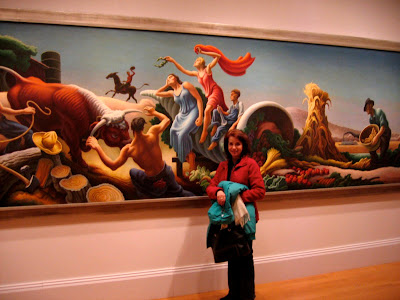A Visit to the Smithsonian American Art Museum
Last Sunday my wife Alice and I drove down to Washington, DC for an afternoon at the Smithsonian American Art Museum (SAAM). If the heavens opened up and in a booming voice God announced he is going to destroy all art museums except one and he's going to make me choose which one to spare, I'd reluctantly have to issue the white arm band to the SAAM. It just has so many of my favorite paintings. It'd be a tough choice as I have a soft spot in my heart for little regional museums, but in the face of divine wrath, what's one to do?
Above is Alice standing in front of one of my favorite's, Thomas Hart Benton's huge Achelous & Hercules, 1947. It is a massive, impressive painting. Here I am below standing by the other end of the same painting. Benton had a marvelous sense of expressive silhouettes and knew how to squeeze the empty spaces between the figures and animals to create wonderfully charged intervals of empty space.
I had already fallen in love with Benton when years ago I read a piece by the then lead art critic for the New York Times, Hilton Kramer, where he called Benton a cheap and overly theatrical cartoonist. Shortly after, I happened to be standing in a New York blue chip art gallery viewing a not very inspiring show of paintings by a painter I thought really 2nd rate. When I'd entered the gallery a young gallery attendant glanced at me with remarkable indifference and remained silent in the face of my "Hello."
A minute later in walks a somewhat weary well dressed man to likewise take in the show. I sensed immediately from the surge of anxious energy that propelled the young gallery attendant to his feet that this was no ordinary gallery visitor. With enormous deference the young attendant walked over to the second visitor and bowed slightly as he asked "Would Mr. Kramer care for a glass of wine?" Mr. Kramer responded with a weak smile and nodded saying he'd care for a chardonnay. I bit my lip to stifle myself from chirping in "I'll have the chardonnay too." Sure would have been fun to say it though just to see what would have happened. A few days later I read Kramer's glowing review of the same exhibit of the paintings I hadn't liked. Must have been really good wine they served him.
The little Benton oil Wheat hanging next to the artist's huge mural at SAAM last Sunday shows Benton was anything but cheap or a cartoonist in my book. It's a lovely and infinitely subtle study of the rhythms of crowded stalks in seemingly endless planted rows. This kid in me want to play hide and seek in between those rows.
Below is a Morris Kantor oil hanging in the same gallery. Years ago when I studied at the Art Students League of New York Kantor was an instructor there. At the time I knew nothing about him and chose other classes. Looking at this painting makes me think he probably would have had some good things to say about painting.
And finally below a last oil hanging in the same gallery at SAAM. It's a Joseph Stella painting. I'm tempted to title my photograph Alice in Wonderland, as Stella creates an amazingly plausible fantasy world. He's particularly good at playing off areas of decorative pattern against empty spaces that allow the viewer's eye to rest. Alice commented "I like the duck" though I suspect it's more of a goose.
Not far down the hall is a masterpiece by Rockwell Kent. To my mind it is one of this artist's very best oil paintings. In it he reaches the very high level he achieves in his elegant wood engravings. Kent's work is far too little known in the US. I would recommend to anybody to pick a paperback copy of the edition of Moby Dick illustrated by Kent. Prepare to have your mind blown by the quality of his prints.
Interestingly, Kent was briefly employed as a studio assistant to our next artist, Abbott Thayer. Thayer to his credit realized early on how talented Kent was and urged him to stop working for others and concentrate on developing his own vision.
If there is any artist who could make me believe in angels, it would be Abbot Thayer. Below I am standing in front of his heartbreakingly beautiful Stevenson Memorial. It was painted many think as a remembrance of his deceased wife and has an almost otherworldly tenderness to it. I think a lot of Thayer's brilliance comes from his understanding of light and shadow. He fills the painting with elegant gradations of tone. It is very rare to see such nuance and subtlety on such a large oil painting. Hats off to this guy.
To close here's a photo a fellow offered to take of Alice and myself standing in front of work by one of her favorite artists, Albert Pinkham Ryder. As sailboats have been such a meaningful symbol to me throughout my life, I thought it appropriate to stand beneath one of Ryder's paintings of threatened mariners.










